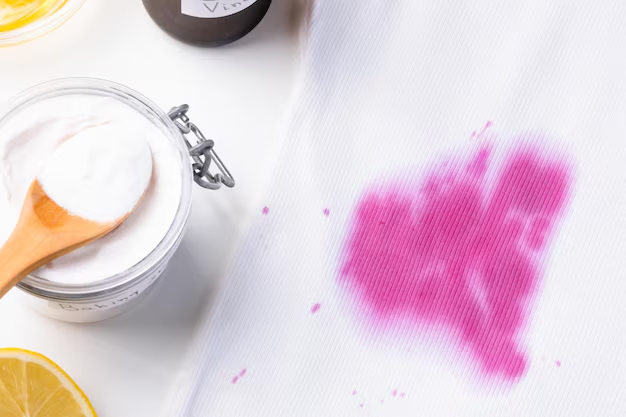Wave Goodbye to Unwanted Stains: Mastering the Art of Removing Dye Transfer from Colored Clothes
We’ve all been there: you pull out a freshly washed load of laundry only to discover your favorite colored shirt has somehow absorbed the dye from another item. The vibrant hue that made your garment stand out has been compromised, leaving behind a telltale stain that no one wants to see. Fear not, as tackling dye transfer stains may not be as daunting as it seems. Let’s explore how you can preserve the color integrity of your clothes by understanding and effectively addressing dye transfer issues.
🚩 The Dreaded Dye Transfer: What Is It?
Dye transfer occurs when the dye from one garment bleeds onto another during the wash cycle. This often happens with new or non-colorfast items, and can particularly affect clothes washed in warm or hot water. Understanding the conditions that lead to dye transfer is key to preventing it in the future and knowing how to treat it when it does occur.
Common Culprits
Some fabrics are more prone to dye bleeding than others. Here's a list of offenders you should be wary of:
- Dark Denim: Jeans can be notorious for bleeding, especially when new.
- Brightly Colored Cottons: Bold shades like reds, blues, and greens.
- Silks and Satins: These delicate fabrics may release dye more easily.
- Cheaply Dyed Clothes: Bargain brands may cut costs with lower-quality dyes.
💡 Prevention is Key: Tips on Avoiding Dye Transfer
Before diving into stain removal techniques, here are some preventive measures to consider:
- Sort Wisely: Always separate your laundry based on colors and fabric types.
- Wash New Clothes Separately: New clothes may continue to bleed dye for several washes.
- Use Cold Water: Cold water helps lock in colors and reduce bleeding.
- Color Catcher Sheets: These products trap loose dyes in the water before they can transfer onto other clothes.
Step-by-Step Guide to Safeguarding Your Laundry
- Read Labels: Pay attention to washing instructions that pertain to water temperature and fabric care.
- Perform a Colorfast Test: Before washing, wet a corner of the item, and dab it with a white cloth to check if the dye bleeds.
- Turn Clothes Inside Out: This helps reduce abrasion and exposure to detergents.
- Avoid Overloading the Washer: Giving clothes ample space can prevent entanglement and friction, which promotes color bleeding.
🧽 Immediate Actions: The First Line of Defense Against Dye Transfer
When you spot a dye transfer stain, it’s essential to act quickly before the stain sets:
Steps to Treat Dye Transfer Immediately
- Don’t Dry: Avoid putting stained clothes in the dryer as heat can set the stain.
- Rewash with Detergent: Run the garment through another wash cycle with only detergent and cold water.
- Use the Right Detergents: Opt for heavy-duty detergents that are designed to fight stains.
- Inspect Before Drying: Ensure the stain is out before you move the clothes to the dryer.
🧪 Specialized Treatments: Products and Methods for Stubborn Stains
If a regular wash doesn’t remove the dye transfer, here’s a deeper dive into other techniques:
Homemade Solutions
Sometimes, the best remedies can be made from everyday items you have at home.
Vinegar and Baking Soda Solution:
- Mix a 1:1 ratio of vinegar and water.
- Apply the mixture directly to the stain.
- Sprinkle baking soda over the area and let it fizz.
- Gently rub, then rinse with cold water.
Hydrogen Peroxide (for light colors):
- Mix equal parts hydrogen peroxide and water.
- Soak the affected area in the solution.
- Rinse and repeat until the stain diminishes.
Commercial Stain Removers
For persistent stains, commercially available stain removers might be necessary.
- Use oxygen bleach (not chlorine bleach) as it’s color-safe.
- Test in an inconspicuous area first to ensure it won’t damage the fabric.
- Follow manufacturer instructions closely.
💬 FAQs: Addressing Common Concerns
Can dye transfer stains be fully removed?
In many cases, yes. However, older stains might not come out completely. Prompt treatment increases the chances of a successful outcome.
Are there specific fabrics that can’t be treated with these methods?
Delicate fabrics like wool or silk should be treated with caution and may require professional cleaning.
How can I tell if a garment is colorfast?
Performing a colorfast test as noted earlier in the article before washing can help determine this.
📝 Quick Reference Guide: Dye Transfer Removal at a Glance
Practical Tips for Removal & Prevention 🌟
- Sort by Color: Keep lights, darks, and colors separate.
- Use Cold Water: Reduces risk of dye bleeding.
- Check Laundry Loads: Avoid overloading machines.
- Test New Clothes: Always test new items for colorfastness.
- DIY Treatments: Vinegar, baking soda, and hydrogen peroxide can be effective in specific cases.
While dealing with dye transfer stains can be frustrating, they don’t have to mean the end for your favorite clothes. By arming yourself with the right knowledge and tools, you can tackle these stains head-on. Taking preventive measures and knowing how to respond promptly when they do occur can save you a lot of future headaches—and maybe a few wardrobe favorites, too. Happy laundering!

Related Topics
- How Can I Transfer Data From One Laptop To Another
- How Can I Transfer Domain To Godaddy
- How Can I Transfer My Calls To Another Phone
- How Can I Transfer Pdf To Word
- How Can We Transfer Data From One Laptop To Another
- How Can You Transfer Data From One Phone To Another
- How Can You Transfer Emails From One Account To Another
- How Can You Transfer Vhs Tapes To Dvd
- How Do I Transfer a Prescription From Walgreens To Cvs
- How Do I Transfer Data From Ipad To Ipad